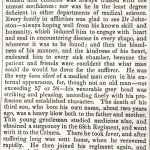The first census in Scotland was carried out in 1801 and this only contained statistical information (occasionally some parishes listed names). The 1841 Census was the first time every parish recorded the names of all individuals within a household, ages, occupations and county or country of birth.
Every household would have received a schedule to complete with the names of all persons present at the residence on the night of 6 Jun 1841. Anyone refusing to complete the schedule or using false information could be fined. The enumerator, who was often a schoolmaster, then collected the schedules the day after and transcribed the contents into an enumerator’s book. The original schedules should then have been destroyed. However, at Stirling Council Archives we have discovered a small bundle of schedules for the 1841 Census (B66/25/805). Shown below is one of the schedules. Most of the bundle contains schedules for residents of Upper Craigs, Stirling but this schedule is for the Johnston family living at Pitt Terrace, Stirling.
Stirling Council Archives also holds microfiche for the 1841 Census of the parish of Stirling.

Comparing the entries in the schedule with those in the published census reveals some differences.
- The 1841 census rounded ages down to the nearest 5th or 10th year for individuals aged 15 and over. When Alexander Johnston filled in the schedule he appears to have given the exact ages of his servants. The enumerator rounded the age of the 26 year old down to 25 but left the 21 year old as 21. Errors were not uncommon in the census.
- Alexander has also provided middle initials for some of his family members, however, the enumerator chose to exclude these in his transcription.
To find out more about the surgeon, Alexander Johnston, and his family we looked for reports in the newspapers. Volumes of the Stirling Observer are available to view at Stirling Council Archives. On 27 November 1856 the Observer reports that a portrait of ‘our respected townsman, Dr Alex. Johnston’ has been added to Mr Young’s Picture Gallery on Baker St, Stirling. The report continues ‘From the great respect in which the Doctor is held, we have no doubt that many will put themselves in possession of a copy’.
The Stirling Observer also contains obituaries for both Alexander and his son of the same name. Alexander (senior) died from ‘a painful and lingering disease of some months’ continuance’. His son Alexander (junior) also studied medicine and served in Crimea. He sadly died on return to Portsmouth after falling ill in Crimea.
Stirling Council Archives also holds burial records for St Ninian’s Old Churchyard (PR/SN/5/1).
Alexander’s burial took place on 30 September 1857. His age is wrongly recorded as 77. Based on the census records he would have been about 57. Unusual for burial records, the cause of death is included. He died from a disease of the stomach. The record also provides details of where his grave is located in the cemetery which can be helpful if you want to visit the grave. The gravestone’s monumental inscription can be a great source of information about the deceased and their family.
If you would like to read the diaries of another surgeon living in Stirling in the 1800s, please take a look at our previous blog of Dr Thomas Lucas.







